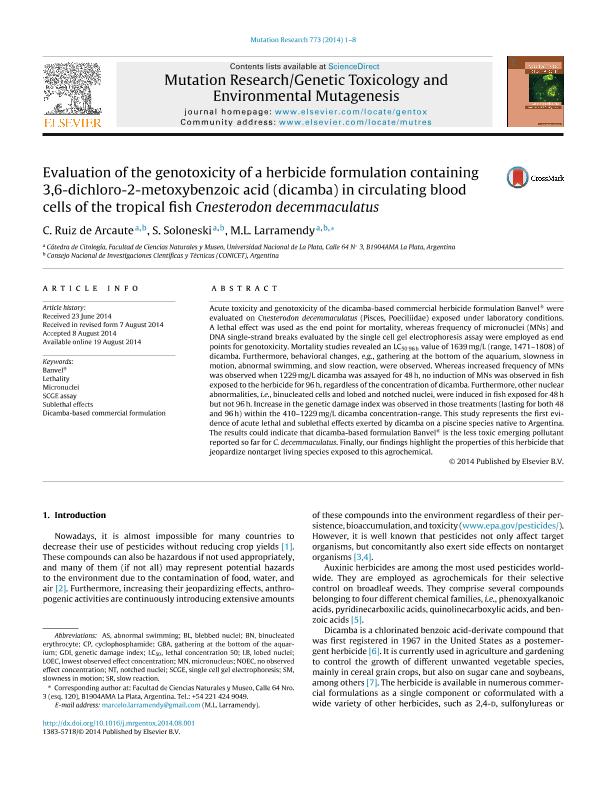Mostrar el registro sencillo del ítem
dc.contributor.author
Ruiz de Arcaute, Celeste

dc.contributor.author
Soloneski, Sonia Maria Elsa

dc.contributor.author
Larramendy, Marcelo Luis

dc.date.available
2018-01-08T19:48:12Z
dc.date.issued
2014-08
dc.identifier.citation
Larramendy, Marcelo Luis; Ruiz de Arcaute, Celeste; Soloneski, Sonia Maria Elsa; Evaluation of the genotoxicity of a herbicide formulation containing 3,6-dichloro-2-metoxybenzoic acid (dicamba) in circulating blood cells of the tropical fish Cnesterodon decemmaculatus; Elsevier Science; Mutation Research. Genetic Toxicology And Environmental Mutagenesis; 773; 8-2014; 1-8
dc.identifier.issn
1383-5718
dc.identifier.uri
http://hdl.handle.net/11336/32572
dc.description.abstract
Acute toxicity and genotoxicity of the dicamba-based commercial herbicide formulation Banvel® were evaluated on Cnesterodon decemmaculatus (Pisces, Poeciliidae) exposed under laboratory conditions. A lethal effect was used as the end point for mortality, whereas frequency of micronuclei (MNs) and DNA single-strand breaks evaluated by the single cell gel electrophoresis assay were employed as end points for genotoxicity. Mortality studies revealed an LC50 96 h value of 1639 mg/L (range, 1471–1808) of dicamba. Furthermore, behavioral changes, e.g., gathering at the bottom of the aquarium, slowness in motion, abnormal swimming, and slow reaction, were observed. Whereas increased frequency of MNs was observed when 1229 mg/L dicamba was assayed for 48 h, no induction of MNs was observed in fish exposed to the herbicide for 96 h, regardless of the concentration of dicamba. Furthermore, other nuclear abnormalities, i.e., binucleated cells and lobed and notched nuclei, were induced in fish exposed for 48 h but not 96 h. Increase in the genetic damage index was observed in those treatments (lasting for both 48 and 96 h) within the 410–1229 mg/L dicamba concentration-range. This study represents the first evidence of acute lethal and sublethal effects exerted by dicamba on a piscine species native to Argentina. The results could indicate that dicamba-based formulation Banvel® is the less toxic emerging pollutant reported so far for C. decemmaculatus. Finally, our findings highlight the properties of this herbicide that jeopardize nontarget living species exposed to this agrochemical.
dc.format
application/pdf
dc.language.iso
eng
dc.publisher
Elsevier Science

dc.rights
info:eu-repo/semantics/openAccess
dc.rights.uri
https://creativecommons.org/licenses/by-nc-sa/2.5/ar/
dc.subject
Banvel
dc.subject
Lethality
dc.subject
Micronuclei
dc.subject
Scge Assay
dc.subject
Sublethal Effects
dc.subject
Dicamba-Based Commercial Formulation
dc.subject.classification
Otras Ciencias Biológicas

dc.subject.classification
Ciencias Biológicas

dc.subject.classification
CIENCIAS NATURALES Y EXACTAS

dc.title
Evaluation of the genotoxicity of a herbicide formulation containing 3,6-dichloro-2-metoxybenzoic acid (dicamba) in circulating blood cells of the tropical fish Cnesterodon decemmaculatus
dc.type
info:eu-repo/semantics/article
dc.type
info:ar-repo/semantics/artículo
dc.type
info:eu-repo/semantics/publishedVersion
dc.date.updated
2018-01-08T18:42:08Z
dc.journal.volume
773
dc.journal.pagination
1-8
dc.journal.pais
Países Bajos

dc.journal.ciudad
Amsterdam
dc.description.fil
Fil: Ruiz de Arcaute, Celeste. Consejo Nacional de Investigaciones Científicas y Técnicas; Argentina. Universidad Nacional de La Plata. Facultad de Ciencias Naturales y Museo. Cátedra de Citología; Argentina
dc.description.fil
Fil: Soloneski, Sonia Maria Elsa. Consejo Nacional de Investigaciones Científicas y Técnicas; Argentina. Universidad Nacional de La Plata. Facultad de Ciencias Naturales y Museo. Cátedra de Citología; Argentina
dc.description.fil
Fil: Larramendy, Marcelo Luis. Consejo Nacional de Investigaciones Científicas y Técnicas; Argentina. Universidad Nacional de La Plata. Facultad de Ciencias Naturales y Museo. Cátedra de Citología; Argentina
dc.journal.title
Mutation Research. Genetic Toxicology And Environmental Mutagenesis

dc.relation.alternativeid
info:eu-repo/semantics/altIdentifier/doi/http://dx.doi.org/10.1016/j.mrgentox.2014.08.001
dc.relation.alternativeid
info:eu-repo/semantics/altIdentifier/url/http://www.sciencedirect.com/science/article/pii/S1383571814002198
Archivos asociados
